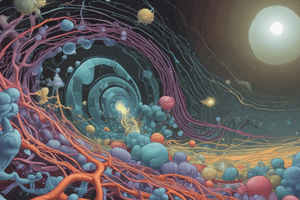Podcast
Questions and Answers
What is unique about post-translational protein translocation?
What is unique about post-translational protein translocation?
- It only occurs in eukaryotic cells
- Precursors are completely synthesized in the cytosol (correct)
- It requires ongoing translation
- It is more common in bacterial plasma membranes
What is the function of the Sec61 translocator in post-translational translocation?
What is the function of the Sec61 translocator in post-translational translocation?
- To prevent precursor folding in the cytosol
- To facilitate the transport of unfolded polypeptides (correct)
- To facilitate the transport of folded proteins
- To hydrolyze ATP for protein translocation
What type of proteins interact with precursor proteins in the cytosol?
What type of proteins interact with precursor proteins in the cytosol?
- Translocator proteins
- Signal peptide proteins
- Accessory proteins
- Chaperone proteins (correct)
What is the function of BiP in co-translational translocation?
What is the function of BiP in co-translational translocation?
What is the role of ATP hydrolysis by BiP?
What is the role of ATP hydrolysis by BiP?
What is the function of the signal peptide in co-translational translocation?
What is the function of the signal peptide in co-translational translocation?
What is the function of Sec62 and Sec63 in co-translational translocation?
What is the function of Sec62 and Sec63 in co-translational translocation?
What is the difference between post-translational and co-translational translocation?
What is the difference between post-translational and co-translational translocation?
What is the role of general chaperone proteins in post-translational translocation?
What is the role of general chaperone proteins in post-translational translocation?
What is the result of BiP binding to the unfolded polypeptide chain?
What is the result of BiP binding to the unfolded polypeptide chain?
Flashcards are hidden until you start studying
Study Notes
Protein Trafficking Ways
- There are four fundamentally different ways a protein is moved from one compartment to another:
- Protein translocation: direct transport of specific proteins from the cytosol into a topologically distinct space (e.g., ER lumen or mitochondrial membrane)
- Gated transport: movement of proteins and RNA molecules between the cytosol and the nucleus through nuclear pore complexes
- Vesicular transport: transport of proteins and lipids between compartments using membrane-enclosed transport intermediates
- Engulfment: formation of autophagosomes or other membrane-bound structures that engulf portions of the cytoplasm
Sorting Signals and Receptors
- Sorting signals are usually composed of amino acid side chains in a protein and come in two general varieties:
- Signal patch: a specific three-dimensional arrangement of amino acids
- Signal sequence: a linear sequence of about 5-10 predominantly hydrophobic amino acids
- Examples of signal sequences that direct proteins to different intracellular locations:
- Proteins destined for mitochondria have signal sequences that include positively charged amino acids
- Proteins destined for the nucleus have signal sequences composed primarily of positively charged amino acids
- Proteins destined for peroxisomes have a signal sequence of three characteristic amino acids at their C-terminus
The Endoplasmic Reticulum (ER)
- The ER membrane typically constitutes more than half of the total membrane of an average animal cell
- The ER is organized into a netlike labyrinth of branching tubules and flattened sacs that extend throughout the cytosol
- The ER is specialized in regions that make intimate contacts with other organelles, such as mitochondria, plastids, endosomes, and the plasma membrane
- The ER can be specialized in regions that make intimate contacts with the plasma membrane, modulating levels of plasma membrane phosphoinositides
Signal Sequence Discovery
- The signal hypothesis was formulated to explain the observations of secreted water-soluble proteins that are first translocated across the ER membrane
- The signal sequence is a linear sequence of about 5-10 predominantly hydrophobic amino acids at the N-terminus of the polypeptide chain
- The signal sequence is cleaved off by a signal peptidase in the ER membrane before the polypeptide chain has been completed
Signal-Recognition Particle (SRP) Directs the ER Signal Sequence to a Specific Receptor at the ER
- SRP is a large complex that binds to the signal sequence and guides it to the ER membrane
- SRP is a hinged rod-like structure that can wrap along the large ribosomal subunit
- The signal-recognition particle (SRP) exposes a binding site for an SRP receptor, which brings the SRP-ribosome complex to an unoccupied protein translocator in the ER membrane
Post-Translational Translocation
- Post-translational translocation: proteins are completely synthesized in the cytosol as precursors before they are imported into the ER
- In yeast and bacteria, post-translational translocation is more common across the ER membrane and the evolutionarily related bacterial plasma membrane
Studying That Suits You
Use AI to generate personalized quizzes and flashcards to suit your learning preferences.



